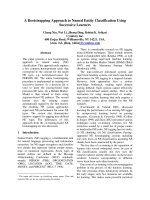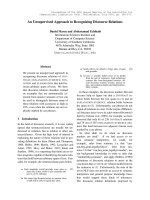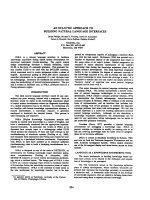Báo cáo khoa học: "An Information-State Approach to Collaborative Reference" pptx
Bạn đang xem bản rút gọn của tài liệu. Xem và tải ngay bản đầy đủ của tài liệu tại đây (43.95 KB, 4 trang )
Proceedings of the ACL Interactive Poster and Demonstration Sessions,
pages 1–4, Ann Arbor, June 2005.
c
2005 Association for Computational Linguistics
An Information-State Approach to Collaborative Reference
David DeVault
1
Natalia Kariaeva
2
Anubha Kothari
2
Iris Oved
3
and Matthew Stone
1
1
Computer Science
2
Linguistics
3
Philosophy and Center for Cognitive Science
Rutgers University
Piscataway NJ 08845-8020
Abstract
We describe a dialogue system that works
with its interlocutor to identify objects.
Our contributions include a concise, mod-
ular architecture with reversible pro-
cesses of understanding and generation,
an information-state model of reference,
and flexible links between semantics and
collaborative problem solving.
1 Introduction
People work together to make sure they understand
one another. For example, when identifying an ob-
ject, speakers are prepared to give many alternative
descriptions, and listeners not only show whether
they understand each description but often help the
speaker find one they do understand (Clark and
Wilkes-Gibbs, 1986). This natural collaboration is
part of what makes human communication so robust
to failure. We aim both to explain this ability and to
reproduce it.
In this paper, we present a novel model of collab-
oration in referential linguistic communication, and
we describe and illustrate its implementation. As we
argue in Section 2, our approach is unique in com-
bining a concise abstraction of the dynamics of joint
activity with a reversible grammar-driven model of
referential language. In the new information-state
model of reference we present in Section 3, inter-
locutors work together over multiple turns to asso-
ciate an entity with an agreed set of concepts that
characterize it. On our approach, utterance planning
and understanding involves reasoning about how
domain-independent linguistic forms can be used
in context to contribute to the task; see Section 4.
Our system reduces to four modules: understanding,
update, deliberation and generation, together with
some supporting infrastructure; see Section 5. This
design derives the efficiency and flexibility of refer-
ential communication from carefully-designed rep-
resentation and reasoning in this simple architecture;
see Section 6. With this proof-of-concept implemen-
tation, then, we provide a jumping-off point for more
detailed investigation of knowledge and processes in
conversation.
2 Overview and Related Work
Our demonstration system plays a referential com-
munication game, much like the one that pairs of
human subjects play in the experiments of Clark and
Wilkes-Gibbs (1986). We describe each episode in
this game as an activity involving the coordinated
action of two participants: a director D who knows
the referent R of a target variable T and a matcher
M whose task is to identify R. Our system can play
either role, D or M, using virtual objects in a graph-
ical display as candidate targets and distractors, and
using text as its input and output. Our system uses
the same task knowledge and the same grammar
whichever role it plays. Of course, the system also
draws on private knowledge to decide how best to
carry out its role; for now it describes objects using
the domain-specific iteration proposed by Dale and
Reiter (1995). The knowledge we have formalized is
targeted to a proof-of-concept implementation, but
we see no methodological obstacle in adding to the
1
system’s resources.
We exemplify what our system does in (1).
(1) a. S: This one is a square.
b. U: Um-hm
c. S: It’s light brown.
d. U: You mean like tan?
e. S: Yeah.
f. S: It’s solid.
g. U: Got it.
The system (S) and user (U) exchange seven utter-
ances in the course of identifying a tan solid square.
We achieve this interaction using the information-
state approach to dialogue system design (Larsson
and Traum, 2000). This approach describes dialogue
as a coordinated effort to maintain an agreed record
of the state of the conversation. Our model contrasts
with traditional plan-based models, as exemplified
by Heeman and Hirst’s model of goals and beliefs
in collaborative reference (1995). Our approach ab-
stracts away from such details of individuals’ men-
tal states and cognitive processes, for principled rea-
sons (Stone, 2004a). We are able to capture these
details implicitly in the dynamics of conversation,
whereas plan-based models must represent them ex-
plicitly. Our representations are simpler than Hee-
man and Hirst’s but support more flexible dialogue.
For example, their approach to (1) would have in-
terlocutors coordinating on goals and beliefs about
a syntactic representation for the tan solid square;
for us, this description and the interlocutors’ com-
mitment to it are abstract results of the underlying
collaborative activity.
Another important antecedent to our work is
Purver’s (2004) characterization of clarification of
names for objects and properties. We extend this
work to develop a treatment of referential descriptive
clarification. When we describe things, our descrip-
tions grow incrementally and can specify as much
detail as needed. Clarification becomes correspond-
ingly cumulative and open-ended. Our revised in-
formation state includes a model of cumulative and
open-ended collaborative activity, similar to that ad-
vocated by Rich et al. (2001). We also benefit from
a reversible goal-directed perspective on descriptive
language (Stone et al., 2003).
3 Information State
Our information state (IS) models the ongoing col-
laboration using a stack of tasks. For a task of col-
laborative reference, the IS tracks how interlocutors
together set up and solve a constraint-satisfaction
problem to identify a target object. In any state, D
and M have agreed on a target variable T and a set of
constraints that the value of T must satisfy. When M
recognizes that these constraints identify R, the task
ends successfully. Until then, D can take actions
that contribute new constraints on R. Importantly,
what D says adds to what is already known about R,
so that the identification of R can be accomplished
across multiple sentences with heterogeneous syn-
tactic structure.
Our IS also allows subtasks of questioning or clar-
ification that interlocutors can use to maintain align-
ment. The same constraint-satisfaction model is
used not only for referring to displayed objects but
also for referring to abstract entities, such as actions
or properties. Our IS tracks the salience of entity
and property referents and, like Purver’s, maintains
the previous utterance for reference in clarification
questions. Note, however, that we do not factor
updates to the IS through an abstract taxonomy of
speech acts. Instead, utterances directly make do-
main moves, such as adding a constraint, so our ar-
chitecture allows utterances to trigger an open-ended
range of domain-specific updates.
4 Linguistic Representations
The way utterances signal task contributions is
through a collection of presupposed constraints. To
understand an utterance, we solve the utterance’s
grammatically-specified semantic constraints. An
interpretation is only feasible if it represents a
contextually-appropriate contribution to the ongoing
task. Symmetrically, to generate an utterance, we
use the grammar to formulate a set of constraints;
these constraints must identify the contribution the
system intends to make. We view interpreted lin-
guistic structures as representing communicative in-
tentions; see (Stone et al., 2003) or (Stone, 2004b).
As in (DeVault et al., 2004), a knowledge in-
terface mediates between domain-general meanings
and the domain-specific ontology supported in a par-
ticular application. This allows us to build inter-
2
pretations using domain-specific representations for
referents, for task moves, and for the domain prop-
erties that characterize referents.
5 Architecture
Our system is implemented in Java. A set of in-
terface types describes the flow of information and
control through the architecture. The representation
and reasoning outlined in Sections 3 and 4 is ac-
complished by implementations of these interfaces
that realize our approach. Modules in the architec-
ture exchange messages about events and their in-
terpretations. (1) Deliberation responds to changes
in the IS by proposing task moves. (2) Generation
constructs collaborative intentions to accomplish the
planned task moves. (3) Understanding infers col-
laborative intentions behind user actions. Genera-
tion and understanding share code to construct inten-
tions for utterances, and both carry out a form of in-
ference to the best explanation. (4) Update advances
the IS symmetrically in response to intentions sig-
naled by the system or recognized from the user;
the symmetric architecture frees the designer from
programming complementary updates in a symmet-
rical way. Additional supporting infrastructure han-
dles the recognition of input actions, the realization
of output actions, and interfacing between domain
knowledge and linguistic resources.
Our system is designed not just for users to inter-
act with, but also for demonstrating and debugging
the system’s underlying models. Processing can be
paused at any point to allow inspection of the sys-
tem’s representations using a range of visualization
tools. You can interactively explore the IS, including
the present state of the world, the agreed direction
of the ongoing task, and the representation of lin-
guistic distinctions in salience and information sta-
tus. You can test the grammar and other interpretive
resources. And you can visualize the search space
for understanding and generation.
6 Example
Let us return to dialogue (1). Here the system rep-
resents its moves as successively constraining the
shape, color and pattern of the target object. In gen-
erating (1c), the system iteratively elaborates its de-
scription from brown to light brown in an attempt
to identify the object’s color unambiguously. The
user’s clarification request at (1d) marks this de-
scription of color as problematic and so triggers a
nested instance of the collaborative reference task.
At (1e) the system adds the user’s proposed con-
straint and (we assume) solves this nested subtask.
The system returns to the main task at (1f) having
grounded the color constraint and continues by iden-
tifying the pattern of the target object.
Let us explore utterance (1c) in more detail. The
IS records the status of the identification process.
The system is the director; the user is the matcher.
The target is represented provisionally by a dis-
course referent t
1
, and what has been agreed so far
is that the current target is a square of the rele-
vant sort for this task, represented in the agent as
square-figure-object(t
1
). In addition, the system has
privately recorded that square o
1
is the referent it
must identify. For this IS, it is expected that the
director will propose an additional constraint iden-
tifying t
1
. The discourse state represents t
1
as being
in-focus, or available for pronominal reference.
Deliberation now gives the generator a specific
move for the system to achieve:
(2) add-constraint(t
1
, color-sandybrown(t
1
))
The content of the move in (2) is that the system
should update the collaborative reference task to in-
clude the constraint that the target is drawn in a par-
ticular, domain-specific color (RGB value F4-A4-60,
or XHTML standard “sandy brown”). The system
finds an utterance that achieves this by exploring
head-first derivations in its grammar; it arrives at the
derivation of it’s light brown in (3).
(3)
brown [present predicative adjective]
✟
✟
✟
✟
✟
❍
❍
❍
❍
❍
it [subject] light [color degree adverb]
A set of presuppositions connect this linguistic
structure to a task domain; they are given in (4a).
The relevant instances in this task are shown in (4b).
(4) a. predication(M)∧ brown(C)∧ light(C)
b. predication(add-constraint)∧
brown(color-sandybrown)∧
light(color-sandybrown)
3
The utterance also uses it to describe a referent
X so presupposes that in-focus(X) holds. The
move effected by the utterance is schematized as
M(X,C(X)). Given the range of possible task moves
in the current context, the constraints specified by
the grammar for (3) are modeled as determining the
instantiation in (2). The system realizes the utter-
ance and assumes, provisionally, that the utterance
achieves its intended effect and records the new con-
straint on t
1
.
Because the generation process incorporates en-
tirely declarative reasoning, it is normally reversible.
Normally, the interlocutor would be able to identify
the speaker’s intended derivation, associate it with
the same semantic constraints, resolve those con-
straints to the intended instances, and thereby dis-
cover the intended task move. In our example, this
is not what happens. Recognition of the user’s clari-
fication request is triggered as in (Purver, 2004). The
system fails to interpret utterance (1d) as an appro-
priate move in the main reference task. As an alter-
native, the system “downdates” the context to record
the fact that the system’s intended move may be the
subject of explicit grounding. This involves push-
ing a new collaborative reference task on the stack
of ongoing activities. The system remains the direc-
tor, the new target is the variable C in interpretation
and the referent to be identified is the property color-
sandybrown. Interpretation of (1d) now succeeds.
7 Discussion
Our work bridges research on collaborative dialogue
in AI (Rich et al., 2001) and research on pragmat-
ics in computational linguistics (Stone et al., 2003).
The two traditions have a lot to gain from reconcil-
ing their assumptions, if as Clark (1996) suggests,
people’s language use is coextensive with their joint
activity. There are implications both ways.
For pragmatics, our model suggests that language
use requires collaboration in part because reaching
agreement about content involves substantive social
knowledge and coordination. Indeed, we suspect
that collaborative reference is only one of many rel-
evant social processes. For collaborative dialogue
systems, adopting rich declarative linguistic repre-
sentations enables us to directly interface the core
modules of a collaborative system with one another.
In language understanding, for example, we can col-
lapse together notional subprocesses like semantic
reconstruction, reference resolution, and intention
recognition and solve them in a uniform way.
Our declarative, reversible approach supports an
analysis of how the system’s specifications drive its
input-output behavior. The architecture of this sys-
tem thus provides the groundwork for further in-
vestigations into the interaction of social, linguis-
tic, cognitive and even perceptual and developmen-
tal processes in meaningful communication.
Acknowledgements
Supported in part by NSF HLC 0308121. Thanks to
Paul Tepper.
References
H. H. Clark and D. Wilkes-Gibbs. 1986. Referring as a
collaborative process. Cognition, 22:1–39.
H. H. Clark. 1996. Using Language. Cambridge.
R. Dale and E. Reiter. 1995. Computational interpreta-
tions of the Gricean maxims in the generation of refer-
ring expressions. Cognitive Science, 18:233–263.
D. DeVault, C. Rich, and C. L. Sidner. 2004. Natural
language generation and discourse context: Comput-
ing distractor sets from the focus stack. In FLAIRS.
P. Heeman and G. Hirst. 1995. Collaborating on refer-
ring expressions. Comp. Ling., 21(3):351–382.
S. Larsson and D. Traum. 2000. Information state and
dialogue management in the TRINDI dialogue move
engine toolkit. Natural Language Eng., 6:323–340.
M. Purver. 2004. The Theory and Use of Clarification
Requests in Dialogue. Ph.D. thesis, Univ. of London.
C. Rich, C. L. Sidner, and N. Lesh. 2001. COL-
LAGEN: applying collaborative discourse theory to
human-computer interaction. AI Magazine, 22:15–25.
M. Stone, C. Doran, B. Webber, T. Bleam, and M. Palmer.
2003. Microplanning with communicative intentions.
Comp. Intelligence, 19(4):311–381.
M. Stone. 2004a. Communicative intentions and conver-
sational processes. In J. Trueswell and M. K. Tanen-
haus, editors, Approaches to Studying World-Situated
Language Use, pages 39–70. MIT.
M. Stone. 2004b. Intention, interpretation and the com-
putational structure of language. Cognitive Science,
28(5):781–809.
4









